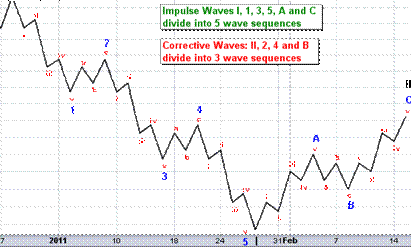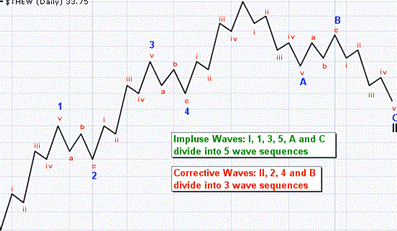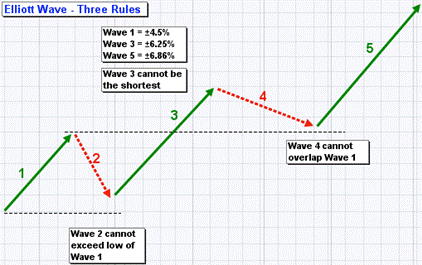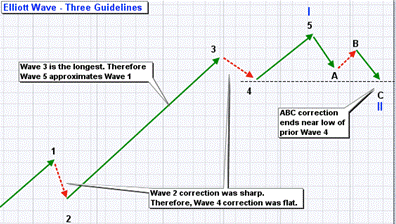Elliott Wave is fractal. This means that wave structure for the Grand Super Cycle is the same as for the minuette. No matter how big or small the wave degree, impulse waves take on a 5-wave sequence and corrective waves take on a 3-wave sequence. Any impulse wave subdivides into 5 smaller waves. Any corrective wave subdivides into three smaller waves. The charts below show the fractal nature of Elliott Wave in action.


Three Rules
There are many guidelines, but only three rules which should not be broken. These rules only apply to a 5-wave impulse sequence. Corrections, which are much more complicated, are given more leeway when it comes to interpretation.
Rule 1: Wave 2 cannot retrace more than 100% of Wave 1.
Rule 2: Wave 3 can never be the shortest of the three impulse waves.
Rule 3: Wave 4 can never overlap Wave 1

Wave 2 cannot move below the low of Wave 1. A break below this low would call for a re-count. Even though Wave 3 is typically the longest of the three impulse waves, there is a specific rule that it cannot be the shortest. 1 or 5 can be longer than Wave 3, but both cannot be longer than Wave 3. It is probably best to use percentages or log scales when measuring Wave length. Elliott Wave indicates that Wave 3 must exceed the high of Wave 1. Failure to exceed this high would call for a re-count. Impulse moves are all about making progress. Failure to exceed the high of Wave 2 would not be making progress. The third, and final rule, is that Wave 4 cannot overlap Wave 1, which means the low of Wave 4 cannot exceed the high of Wave 1. Such a violation would call for a re-count.
Guidelines
There are numerous guidelines, but key guidelines are discussed below.
- Guideline 1: When Wave 3 is the longest impulse wave, Wave 5 will approximately equal Wave 1. This is useful for targeting the end of Wave 5. Even though Wave 5 could be longer than Wave 3 and Wave 3 could still be longer than Wave 1, chartists can make initial Wave 5 projections once Wave 4 ends. In a larger uptrend, chartists apply the length of Wave 1 (percentage change) to the low of Wave 4 for an upside target. The opposite is true for a 5-wave decline. The percentage decline in Wave 1 would be applied to the high of Wave 4 for a Wave 5 estimate.
- Guideline 2: The forms for Wave 2 and Wave 4 will alternate. If Wave 2 is a sharp correction, Wave 4 will be a flat correction. If Wave 2 is flat, Wave 4 will be sharp. The guideline of alternation is useful for determining the time of correction for Wave 4. After a sharp decline for Wave 2, chartists can expect a relatively flat correction for Wave 4. If Wave 2 is relatively flat, then chartists can expect a relatively sharp Wave 4. In practice, Wave 2 tends to be a rather sharp wave that retraces a large portion of Wave 1. Wave 4 comes after an extended Wave 3. This Wave 4 marks more of a consolidation that lays the groundwork for Wave 5 trend resumption.
- Guideline 3: After a 5-wave impulse advance, corrections (abc) usually end in the area of prior Wave 4 low. The guideline is useful for estimating the end of a Wave II correction after a Wave I advance. Waves I and II are the larger degree waves. Waves 1-2-3-4-5 are lesser degree waves within Wave I. Once the Wave II correction unfolds, chartists can estimate its end by looking at the end of the prior wave 4 (lesser degree wave 4). In a larger degree uptrend, Wave II would be expected to bottom near the low of lesser degree Wave 4. In a larger degree downtrend, Wave II would be expected to peak near the high of lesser degree Wave 4.

Apply for Technical Analysis Certification Now!!
http://www.vskills.in/certification/Certified-Technical-Analyst

